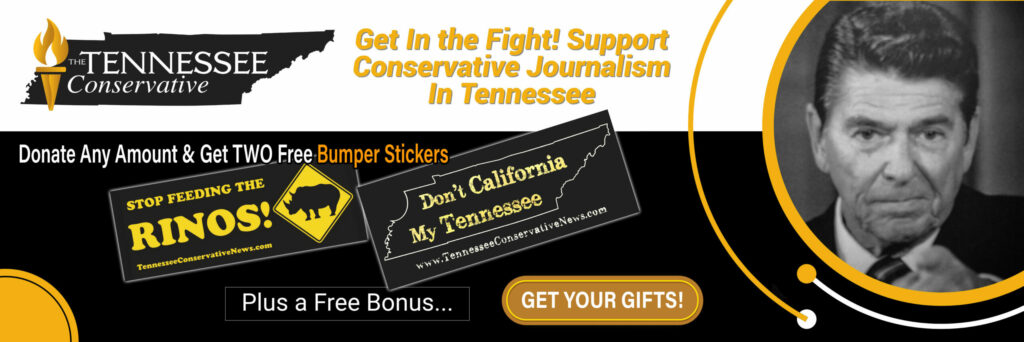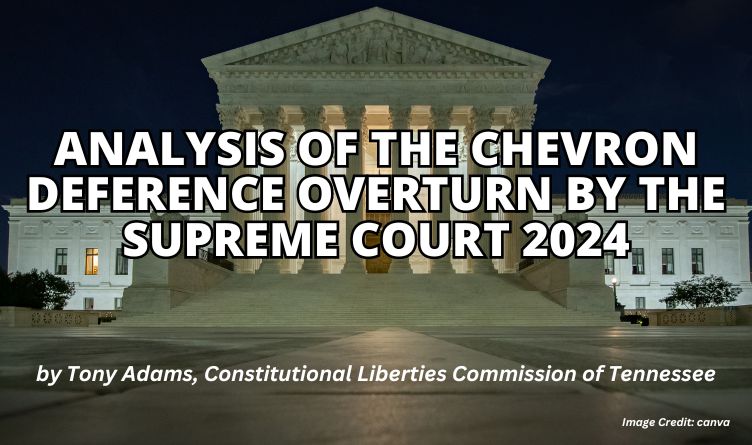Image Credit: Canva
Submitted by Tony Adams [Constitutional Liberties Commission of TN] –
The Supreme Court’s recent decision to overturn *Chevron U.S.A., Inc. v. Natural Resources Defense Council, Inc.* (1984), commonly known as Chevron deference, represents a seismic shift in American administrative law and constitutional interpretation.
Chevron deference had long granted federal agencies significant leeway in interpreting ambiguous statutes, provided their interpretations were “reasonable.”
The doctrine was rooted in the notion that agencies possess specialized expertise and should be trusted to implement complex regulatory frameworks. However, in a political era marked by a conservative tilt on the Supreme Court, the overturning of Chevron reflects a broader agenda aimed at curbing the power of the so-called “administrative state” and reinforcing a strict separation of powers as envisioned by the Founders.
This analysis explores how the decision fits within a conservative constitutional framework, examines the motivations behind the ruling, and discusses its implications for governance, judicial authority, and regulatory policy.

Chevron Deference: Conservative Critique
From a conservative constitutional perspective, Chevron deference had long been a target of criticism. The doctrine effectively allowed executive agencies to wield quasi-legislative and quasi-judicial power, undermining the principles of limited government and separation of powers that are foundational to conservative legal thought.
1. **Constitutional Originalism**: Conservatives adhering to originalist interpretations of the Constitution argue that Chevron deference violated the separation of powers by granting executive agencies authority that properly belongs to the judiciary and Congress. The Constitution’s framers intended for laws to be made by the legislative branch and interpreted by the judiciary. Chevron blurred this boundary, allowing unelected bureaucrats in executive agencies to both interpret and enforce laws with minimal oversight.
2. **Nondelegation Doctrine**: A key component of the conservative constitutional critique of Chevron is rooted in the nondelegation doctrine, which holds that Congress cannot delegate its lawmaking powers to executive agencies. Chevron deference, by allowing agencies to effectively “fill in the blanks” of ambiguous statutes, was seen as a violation of this doctrine. By overturning Chevron, the Supreme Court is signaling a return to a more stringent interpretation of nondelegation, demanding that Congress be more explicit in its statutory language and leaving less room for agency discretion.
3. **Checks and Balances**: Conservatives argue that Chevron disrupted the system of checks and balances, concentrating too much power in the executive branch. By overturning Chevron, the conservative majority on the Supreme Court seeks to restore a balance between the branches of government, reinforcing judicial oversight over executive actions and encouraging Congress to reclaim its legislative role.
Motivations for Overturning Chevron in a Conservative Constitutional Framework
The decision to overturn Chevron deference is deeply rooted in conservative legal philosophy, particularly the doctrines of originalism, textualism, and a desire to curtail the administrative state. Several motivations stand out in explaining the Court’s ruling within this context:
1. **Reining in the Administrative State**: For decades, conservative legal scholars and politicians have been critical of what they view as the unchecked expansion of the administrative state. They argue that federal agencies have used Chevron deference to amass regulatory power that far exceeds their constitutional authority. The overturning of Chevron represents a victory for conservatives who seek to dismantle or limit the reach of the administrative state, particularly in areas such as environmental regulation, labor law, and healthcare policy.
2. **Judicial Empowerment**: The decision reflects a conservative belief in the importance of judicial independence and the judiciary’s role as the ultimate interpreter of law. Chevron deference placed too much faith in executive agencies, according to this view, and eroded the courts’ ability to hold agencies accountable. By overturning Chevron, the Supreme Court is reasserting its constitutional authority to interpret statutes without deferring to agency expertise, a move that aligns with the textualist approach favored by many conservative justices.
3. **Promoting Legislative Responsibility**: Conservatives also see the overturning of Chevron as a way to force Congress to take greater responsibility for its legislative actions. Under Chevron, Congress could pass broad, vague statutes and leave the details of implementation to federal agencies. With Chevron overturned, Congress will now be pressured to write clearer, more specific laws, reducing the scope for agency interpretation and shifting policymaking back to the legislative branch, where conservatives argue it belongs.

Implications of the Chevron Overturn in a Conservative Constitutional Framework
The decision to overturn Chevron will have significant political and governance implications, particularly in terms of the functioning of the federal bureaucracy, the role of the courts, and the legislative process.
1. **Increased Judicial Power**: The primary consequence of the Chevron overturn is the enhanced role of the judiciary in interpreting statutes. Federal courts, rather than deferring to agency expertise, will now independently assess the meaning of ambiguous laws. This shift empowers the judiciary and may lead to more judicial activism in regulatory matters, where courts will have more latitude to strike down or reshape agency rules. While conservatives may welcome this increased judicial oversight, it could also lead to greater uncertainty and variability in regulatory policy as courts take different approaches to statutory interpretation.
2. **Constraints on the Administrative State**: Federal agencies will likely face new challenges in implementing regulations. Without the benefit of Chevron deference, agencies will need to tread carefully when interpreting statutes, knowing that courts may be more willing to overturn their decisions. This could slow the pace of regulatory action, particularly in complex fields like environmental protection, finance, and telecommunications. For conservatives who view the administrative state as overreaching, this is a welcome development, as it limits agencies’ ability to enact broad regulations without explicit congressional authorization.
3. **Legislative Accountability and Gridlock**: By overturning Chevron, the Supreme Court is effectively demanding that Congress take a more active and precise role in lawmaking. While this shift aligns with conservative principles of legislative responsibility, it also raises the specter of legislative gridlock. In an era of deep political polarization, it may be difficult for Congress to pass detailed and specific legislation, leaving regulatory gaps that agencies are no longer able to fill through interpretive discretion. This could result in regulatory paralysis in key areas like climate change, healthcare, and consumer protection.
4. **Impact on Progressive Policy**: The Chevron overturn is likely to have the greatest impact on progressive policies that rely on agency regulation to advance their goals. For example, environmental regulations issued by the EPA, labor protections from the Department of Labor, and financial rules from the Consumer Financial Protection Bureau (CFPB) may face increased legal challenges. Without Chevron, these agencies may find it more difficult to justify their regulations, particularly in conservative-leaning courts. This could lead to a rollback of regulations that progressives view as essential for addressing issues like climate change and income inequality.

Conclusion
The Supreme Court’s decision to overturn Chevron deference marks a significant victory for conservative constitutionalism. It reflects a broader effort to limit the power of the administrative state, restore the judiciary’s role in interpreting laws, and encourage Congress to take greater responsibility for its legislative duties.
While conservatives see this as a necessary correction to decades of regulatory overreach, the decision also raises concerns about regulatory uncertainty, judicial activism, and legislative gridlock.
In the long term, the Chevron overturn may reshape the relationship between the three branches of government, leading to a more constrained and cautious federal bureaucracy, with courts and Congress playing a more active role in shaping policy.




One Response
Thanx!